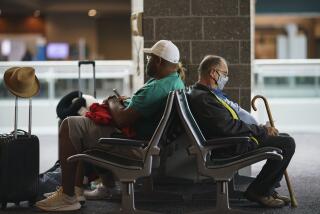EXECUTIVE TRAVEL
- Share via
* Name: John Fleming
* Position: Senior staff scientist
* Company: Science Applications International Corp., Torrance
Not only do I travel a lot on business, but I also participate in various military aircraft exercises. Your article on minimizing the flight safety risk (“Prepared Passengers Minimize Safety Risk,” Jan. 12) reminded me of our safety discussions during a recent training course at Edwards Air Force Base. Crew members, instructors and a Federal Aviation Administration official were in attendance. A couple of interesting notes from those discussions:
* Counting the number of seats between you and the exit can be a problem, since in some crashes the seats become dislodged. People should also count the lights above the seats as a backup guide.
* The experts generally agreed that the safest seat (rear aisle) is the opposite of the traditional business favorite (front window). The rear is more likely to remain intact in a crash and, as your article mentions, there are exits in the rear of most aircraft.
* Your comment on what to wear was excellent and something most people ignore. Cotton clothes and good shoes are important. Additionally, a jacket or a shirt with long sleeves is helpful.
* With respect to the “impact position,” people should be warned to be careful that upon impact, their legs will be shot forward and, if they strike the seat in front, can break. There’s no really good defense except to put your feet against the seat in front of you--with your legs slightly bent. Use them as shock absorbers.
* When exiting, avoid standing upright or crawling. Smoke and fumes accumulate at the ceiling and along the floor.
More to Read
Sign up for The Wild
We’ll help you find the best places to hike, bike and run, as well as the perfect silent spots for meditation and yoga.
You may occasionally receive promotional content from the Los Angeles Times.






